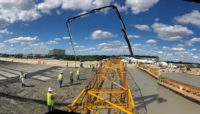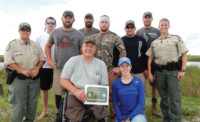Over the last three to four years, Webber LLC has rapidly grown its presence in the Texas marketplace, continuing to be one of the dominant players in transportation construction across the state. And in the last year, the firm tested markets in neighboring states.
In 2017, The Woodlands, Texas-based firm was awarded more than $1 billion in new work and reported regional revenue of $946.6 million across its four business lines: heavy civil, commercial, waterworks and recycled materials.
Construction in the region is booming, particularly in Texas, explains Jose Carlos Esteban, interim CEO of Webber.
“Population growth increases the demand for infrastructure and our strong economy generates the funds to design and construct it. Demographers suggest that the population in Texas will double by 2050,” he says.
However, there has also been a disproportionate increase in competition over the past several years as a result of a large influx of new companies in the Texas construction market, Esteban explains.
“The result is a scarcity of market resources and increased costs while the large volume of bidders keep prices low and margins razor thin. These combined factors provide zero margin for mistakes, and in order to mitigate these risks, we work to recruit and retain the best in the industry,” he says.
To stay ahead, Webber’s teams utilize three key strategies on their projects.
“First, we install a solid team on each project from the outset. Second, we start strong, using abundant resources to get ahead of schedule early on,” Esteban says. “Third, we break the project into internal milestones and incentivize our teams when they are able to meet these established milestones safely and within budget.”
Another strategy for the firm over the past year and a half has been expanding beyond the heavy civil market.
Adding Business Lines
Also during 2017, Webber completed the integration and rebranding of PepperLawson Construction, which Webber acquired in mid-2016, explains Esteban. This transaction brought the firm its two newest market sectors, waterworks and commercial construction.
“The movement into new markets has allowed us to expand our vision beyond transportation to become a more comprehensive infrastructure provider,” Esteban says.
Atul Raj initiated the PepperLawson acquisition because he saw potential for growth in the water sector. Raj led PepperLawson Construction into doing water projects in 1993 and later became co-owner of PepperLawson Waterworks, now PLW Waterworks. He currently serves as president of PLW.
With a growing market for water projects, especially throughout Texas, PLW has had to pass on some good opportunities, Raj explains. “I’ve been in the waterworks business market in Texas now for 33 years, and I’ve never seen this much activity,” Raj says. “However, we’re also faced with challenges with the adequacy of craft labor and also the challenges of the market conditions, with escalation and the tariffs and the political effects of what’s going on internationally.”
PLW is working on the Pearland Reflection Bay Water Reclamation Facility, the largest project in Pearland’s history, Raj explains. When complete at the end of the year, the facility will provide treatment capacity for the next seven to 10 years for the South Houston community.
“It represents a bit of a change for us, in that large projects like this typically work for major cities, Houston, Dallas, etc., and now we’re seeing more projects of this size for suburban communities,” Raj says.
Meanwhile, PepperLawson’s commercial division evolved into Webber Commercial, led by President Todd Granato. “In 2017 to 2018, we’ve grown on average by about 25% to 30% in revenue per year, so the market’s been very good,” he says. Granato previously served as president of PepperLawson since 2014.
Webber Commercial has continued to grow in the K-12 and multifamily sectors and is in the process of doing preconstruction on some hotels, industrial and health care projects. “Those projects are in the preconstruction phase and will not start until 2019,” he adds.
Webber Commercial is pushing beyond the K-12 market. One of its landmark projects is Catalyst Houston, a 28-story, 361-unit luxury apartment building in downtown Houston that finished in late 2017. The Webber Commercial team is already doing preconstruction on several opportunities in downtown Houston. Another tower project could start in the next six to nine months, Granato adds.
“Webber was a heavy civil company, and so of course, acquiring a water division and a commercial division was a little bit different, but they’ve kind of opened up their arms and have provided us all the support we need to continue operating our business lines without changing drastically,” Granato says.
With its other business lines, Heavy Civil and Southern Crushed Concrete (materials), Webber has created a diversified yet cohesive group, Esteban says. Coupling the strong market presence and core competencies of these new sectors with the global resources and experience of both Webber and its parent company Ferrovial, has created a formidable organization with the capacity for even more sustained growth, he explains.
Abundant Projects
Through the first five months of 2018, Webber’s crews have worked a combined 1.67 million man hours in the region. In 2017, Webber’s team worked a total of 4.22 million man hours, up from 2016’s 3.4 million. During the last four years, the firm’s EMR has not edged past 0.6. Webber has earned a bevy of safety awards, including the 2016 ARTBA Large Contractor Safety Award, the National AGC Safety Award for four consecutive years, and AGC Arkansas’s Safety Excellence Award 2018.
“We are constructing larger, more complex projects with both existing and new clients, in hard-bid and alternative-delivery work,” Esteban says.
Webber Commercial has won $130-million’s worth of work under College Station Independent School District’s (CSISD) bond program, notes Granato. “We’ve built an intermediate school, a middle school and an elementary school, and every summer we probably do about five to eight smaller renovations of existing schools,” he says.
The new middle school will open this month—nearly two months late, in part because of significant weather delays. Still, the Webber Commercial team is on track to complete the work on time, says Theo Rouse, coordinator of construction for CSISD, who has worked with the Webber Commercial team for the past four years.
“Webber tells you the truth. If they have issues or problems, they bring them up early, allowing time to resolve them correctly,” Rouse says. “So many contractors today want to sugarcoat the issues until it is sometimes too late and it ends up costing you time and money. These people know what they are doing and they perform well on projects.”
Highway Work
Three of the largest projects Webber broke ground on in 2017 included Grand Parkway, US 281 and I-45, which represent a combined project value of $1.166 billion.
“Webber has been working with the Texas Dept. of Transportation (TxDOT) for more than 30 years and has handled some of Houston’s most challenging projects successfully,” says Quincy Allen, Houston district engineer at TxDOT. “They are proactive and often come up with innovative ideas and solutions to construction problems.”
At the moment, Webber says that all of its TxDOT projects are on time or ahead of schedule. “In Houston, construction of Segments 5, 6 & 7 of US 290 are some of the most transformative works in the area,” Esteban says. “Webber took over Segment 5 after the original contractor defaulted, and we are now on track to beat the original completion target.”
The firm’s first foray into Oklahoma, the US 77 bridge project, removes a two-lane bridge built in 1933 and builds a four-lane bridge in Purcell, McClain County, on US 77.
“The bridge serves as the only direct link between the communities of Purcell and Lexington,” Esteban says. “Without the bridge, commuters must detour to either Oklahoma City or Pauls Valley, each of which takes roughly one hour.”
The $35-million project began in fall 2017 and starts with the removal of the existing bridge and construction of a 3,725-ft-long, four-lane bridge, spanning the Canadian River on the east end and a five-track BNSF railroad siding on the west end.
Meanwhile, Webber’s first Arkansas project reconstructs 10.35 miles of I-530 in Pine Bluff, Jefferson County. The $67-million project removes existing concrete roadway and replaces 329,550 sq yd of 12-in. Portland concrete.
“It’s kind of a complicated project with a lot of phasing issues,” says Webber President and CEO Tim Creson.
“Part of our vision involved developing a culture of operational excellence that clients could appreciate, from project start to completion,” Esteban says. “We are schedule-centric and dedicate the resources necessary to finish ahead of schedule and as early as possible.”
Recovery Efforts
One of Webber’s biggest accomplishments in 2017 was helping employees and the city of Houston recover from Hurricane Harvey. Webber contributed approximately $1 million to Hurricane Harvey relief efforts last year through donations, manpower and employee support programs, in addition to its ongoing support over the years for Habitat for Humanity and Rebuilding Together, Esteban says.
Employees donated both time and money to help one another, and the company double-matched those funds, reaching nearly $100,000 in direct contributions. Volunteer work included assistance through AGC of Texas for TxDOT employees affected by the storm. Webber also contributed $750,000 in payroll to employees who could not work during the hurricane.
“We covered payroll. We didn’t let anybody lose time during the impact,” Creson says.
The firm also played a major role post-Harvey in helping repair roadways across the city. Immediately after the flooding receded, Webber reset nearly 7,500 linear ft of concrete traffic barriers that had shifted from the floodwaters and replaced another 1,500 linear ft that were unsalvageable.
Webber also led a $7.5-million emergency repair project on a section of Interstate 69, just south of Kingwood, Texas, for TxDOT. Floodwaters shifted the depth and alignment of the San Jacinto River, causing scouring and stability problems around the foundations of the southbound bridge.
In just 76 days—14 days ahead of schedule—the Webber team removed and rebuilt three bents and four spans of the southbound I-69 main lanes over the San Jacinto River.
New Leadership
2018 is shaping up to be a better year for Webber than 2017 from the perspective of backlog and revenue, Esteban says.
The firm will also be under new leadership. Creson has led Webber since 2013 as president and CEO, but he announced at the end of July that he would leave the company for new challenges abroad. Esteban was subsequently named interim CEO.
“Tim put the spark back into the company that ignited our growth, and it is now up to the leadership team to take Webber to that next level of success,” Esteban says.
Plans are in motion to establish a regional office on the East Coast, most likely in the Virginia area, Creson says.
“The plan is for Webber to basically be more of a self-performing contractor in that area, in order to do design-build in the $300-million-and-down range, and support our sister company Ferrovial Agroman US,” Creson says.
Webber also has expanded its Central Texas office this year. “The game plan for central Texas, we’ll open an office in 2018, pick up work in 2019, and expand into North Texas here in the next year,” Granato says.










Post a comment to this article
Report Abusive Comment